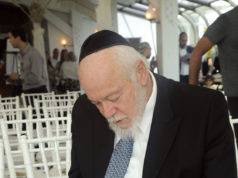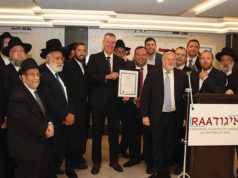
For nearly 1,100 years, Iceland had only one religion. It was a country without minorities. A poor society of farmers inhabited this isolated island. There were no towns or urban settlements. Losing their independence to Norwegian rule in the mid-13th century, then becoming a Danish colony in the 15th century, the inhabitants tried their best to survive under harsh conditions.
Natural catastrophes such as volcanic eruptions and soil erosion, followed by famines and plagues, made life difficult and the population was often on the brink of extinction.
For a very long time, there were no Jews in Iceland. The very first documented information about a Jew in Iceland dates from the mid-1620s. Actually, the first Jew in Iceland was no longer a Jew when he arrived; he had converted to Christianity in Copenhagen. In 1620, Daniel Salomon was baptized and his name changed to Johannes Salomon. Having been a poor Jew from Poland, the baptism gained him a career and respect. He arrived in Iceland in 1625.
In 1704 Jacob Franco, a Dutch Jew of Portuguese origin who had been allowed to settle in Copenhagen, was appointed to prepare and export all the tobacco that was to be sold to merchants in Iceland. In 1710, Abraham Levin and his companion Abraham Cantor of Copenhagen were given similar responsibilities. Isak, the son of Abraham Cantor, held these same responsibilities in 1731.
In 1815 the first “Jewish ship,” the Ulricha, arrived in Iceland. It was rented by a merchant, Ruben Moses Henriques of Copenhagen, who sold all sorts of fabrics, hats and paper at a small trading post in North Iceland.
In 1855 the Icelandic parliament decided that Jews were welcome to settle there, because they were enterprising merchants who did not try to lure others to their religion. It is not known if any Jews accepted this offer.
In the 19th century there were very few Jews in Iceland and many anti-Semites, including the first president of the University of Iceland, Professor Björn M. Ólsen. As a young scholar at the University of Copenhagen, he submitted an essay about a trading firm in North Iceland, which he referred to as the “Jewish congregation of merchants.” He commented: “It is noteworthy that this firm has chosen a Hebrew name, and the Jewishness radiates from all of their activities. This firm wears various disguises, but Jews are always easily recognizable by their voice.”
There were also some 19th-century poets that praised the Jews. The poet and prefect Bjarni Thorarensen wrote, “I say that the entire world has reason to be grateful to the Jews.”
In the late 19th century a small number of the foreign trading agents and wholesale firms that were active in Iceland were owned by Danish Jews.
The Hungarian physician, journalist and Zionist, Max Nordau arrived in Iceland in 1874. In a letter to his family, he wrote that he would rather be a dog in Pest (a section of Budapest) than a traveler in Iceland.
In 1906, a Danish shopkeeper named Fritz Heymann Nathan arrived in Iceland. He quickly became a prosperous merchant. In 1913 he, together with a Danish companion, founded the firm Nathan and Olsen in Reykjavík. After Fritz married in 1917, he quickly realized that because Iceland lacked the means for conducting a Jewish life, he could not keep living there with his family. He settled in Copenhagen, and traveled to and from Iceland and around Europe as an agent for the firm. The firm was highly successful until the Icelandic government introduced trade restrictions in the 1930s. Back in 1916-1917, Fritz Nathan built the then-largest building in Iceland, which is still majestic in appearance. With its five stories it was one of the wonders of Iceland.
It was not until the 1930s that Jewish refugees started arriving and the people of Iceland began encountering Jews on a daily basis. They were called Gyðingar. The word Gyðingar, which has existed in the language since the 11th century, has been the most widely used term for Jews in the Icelandic language and is actually a diminutive form of the word Guð (G-d). The monks who wrote the Icelandic sagas probably invented this word for G-d’s Chosen People.
Iceland’s immigration policy mostly followed the legislation of Denmark. When Denmark shut its gates to the Austrian Jews in May 1938, the authorities in Reykjavík did the same. The situation for Jewish refugees in 1930s Iceland was generally worse than for other foreigners. During the Depression years it was much easier for non- Jewish immigrants, mostly Germans and Scandinavians, to obtain work and residence permits than for Jewish immigrants.
While Iceland was closing its harbors and restricting certain professions to Icelandic citizens, many Icelanders viewed Hitler and Nazism as a key to gaining their independence.
In 1933, a small Nazi Party was founded in Iceland. In 1934, it became a National Socialist Party with connections to the German Nazi Party. The party never gained enough popularity to obtain seats in the parliament, and it gradually dissolved and mixed with other political parties in 1938. Like many other Icelandic politicians, the leading Nazis of Iceland wanted to preserve the purity of the Icelandic race. Although the party could not make Icelandic Jews their archenemies, since there were so few Jews in Iceland, they saw Jews and Jewish conspiracies everywhere.
Although the few Jewish refugees in Iceland had no significant problems with the Icelandic Nazis, they had a basic problem with the nationalistic Icelandic authorities. The Jews were simply not welcome in the country.
Iceland’s officials created all kinds of difficulties to prevent further immigration of foreigners. A foreigner only received a residence permit if he had gained a recommendation from an Icelander as a semi-skilled worker, whose skills were not already available in the country. The prime minister declared that Iceland had always been a pure Nordic country, free of Jews, and he wanted all the Jews that lived there to leave. Many Jews were expelled and sent to Austria and Germany where they were placed in extermination camps.
Only a small number of Icelanders pleaded the case of the Jewish refugees. Generally, however, Icelandic spiritual leaders, ministers, bishops, academics and authors did not lend support to the refugees.
On a cold day in the fall of 1940, Yom Kippur was observed for the first time in Iceland. In fact, this marked both the first Jewish and the first non-Christian service in the country since the Icelanders embraced Christianity in the year 1000. In May of 1940, British forces had arrived in Reykjavík, and more kept coming in the following months. Among them were Jewish servicemen, who immediately sought a synagogue. There was no synagogue to be found.
About 25 Jewish soldiers from England, Scotland and Canada gathered together with eight Jewish refugees. The Icelandic authorities offered a chapel in Reykjavik’s old cemetery to conduct their services. One of the refugees found this proposition insulting and instead rented the hall of the Good Templars’ Lodge for the services. He and his wife improvised to make the hall look like a synagogue, and with some help from a librarian they borrowed the only Torah available in town.
Without a rabbi, with only two talit and one yarmulke, the new congregation’s services went well. Alfred Conway, a cantor from Leeds, sang Kol Nidre. After the full day of fasting and services, the hungry people gathered for a meal at a nearby Reykjavík hotel, and the first Jewish congregation in Iceland was officially founded.
Arnold Zeisel, a manufacturer of leather goods from Vienna, became the first head of the community. In the following years this group gathered regularly. The first bar mitzvah in Iceland took place on the Shabbat of Passover, 1941, though the matzos arrived too late for that Passover. And the community persevered during that year even though the British forces were unwilling to send a rabbi to Iceland.
After the American forces succeeded the British army in 1941- 1942, Jewish life in Reykjavík and on nearby military bases became more active. Late in 1941 an American field rabbi arrived in Iceland, and the congregation had grown so large that a new building had to be found for services. In addition to the congregation of American soldiers, there was an Orthodox congregation that had a synagogue in a hut, opposite the building where the larger community held their services. The American rabbis who were stationed in Iceland during the war maintained contacts with the refugee Jews. The German-speaking Jews liked the modern, fresh approach of the young American rabbis, unlike what they had experienced in Germany or Austria.
At the Rosh Hashanah service in 1944, at the Keflavík airbase, there were 500 Jews present and a Torah scroll was flown in from the US. In 1944 the number of Jewish servicemen in Iceland was estimated at 2,000.
The small Icelandic Jewish population has never played a role in Icelandic-Israeli relations. Iceland was, however, one of the 33 states that voted in favor of Israel’s establishment in the UN Partition Resolution of 1947.
Meanwhile, the Jews in Iceland kept a low profile during the postwar period. Most of them wanted to attract as little attention as possible to their religion, preferring to adopt a new Icelandic identity. With their new, Icelandic names, new lives, and often a new religion, they sought to avoid further unpleasant experiences, having already endured so much as Jews in prewar Europe and during the Holocaust.
With regard to the Holocaust, a few Icelandic members of the Waffen-SS fought for Nazi Germany, and a few Icelanders served in concentration camps in 1943-1944. Most Icelanders who served in the Third Reich were treated with contempt after the war. However, there was a lapse of memory when it came to the former members of Iceland’s own Nazi Party. After the war, some of them quickly attained high positions in society, including a couple of chiefs of police, a bank director, and some doctors.
In 2000, Iceland participated in a Holocaust conference in Stockholm, and it has signed a declaration of the European Council that obliges the member states to teach about the Holocaust in their schools. In reality, this has not meant increased instruction on the Holocaust and genocide in Iceland’s educational system
A Jewish-Icelandic connection was confirmed when the President of Iceland, Ólafur Ragnar Grímsson, married Israeli citizen Dorrit Mussaieff in 2003, making her the world’s first Jewish First Lady outside of Israel. However, anti-Semitism still exists in Iceland.
Nowadays, a new generation of Icelandic Jews gather on the Jewish holidays. They still do not like to attract attention to themselves. Most Icelanders are unaware that there are Jews in the country, and the handful of Jews would rather not change that perception.
______________
DR. VILHJÁLMUR ÖRN VILHJÁLMSSON was born in Reykjavík in 1960, and received a Ph.D. in archeology from the University of Aarhus (Denmark) in 1992. He was an archeologist and a curator at the National Museum of Iceland (1993-1997), and senior researcher at the Danish Center for Holocaust and Genocide Studies (2000-2002). He is currently completing two books about Denmark’s expulsion to Germany of stateless Jews during 1940-1943.



